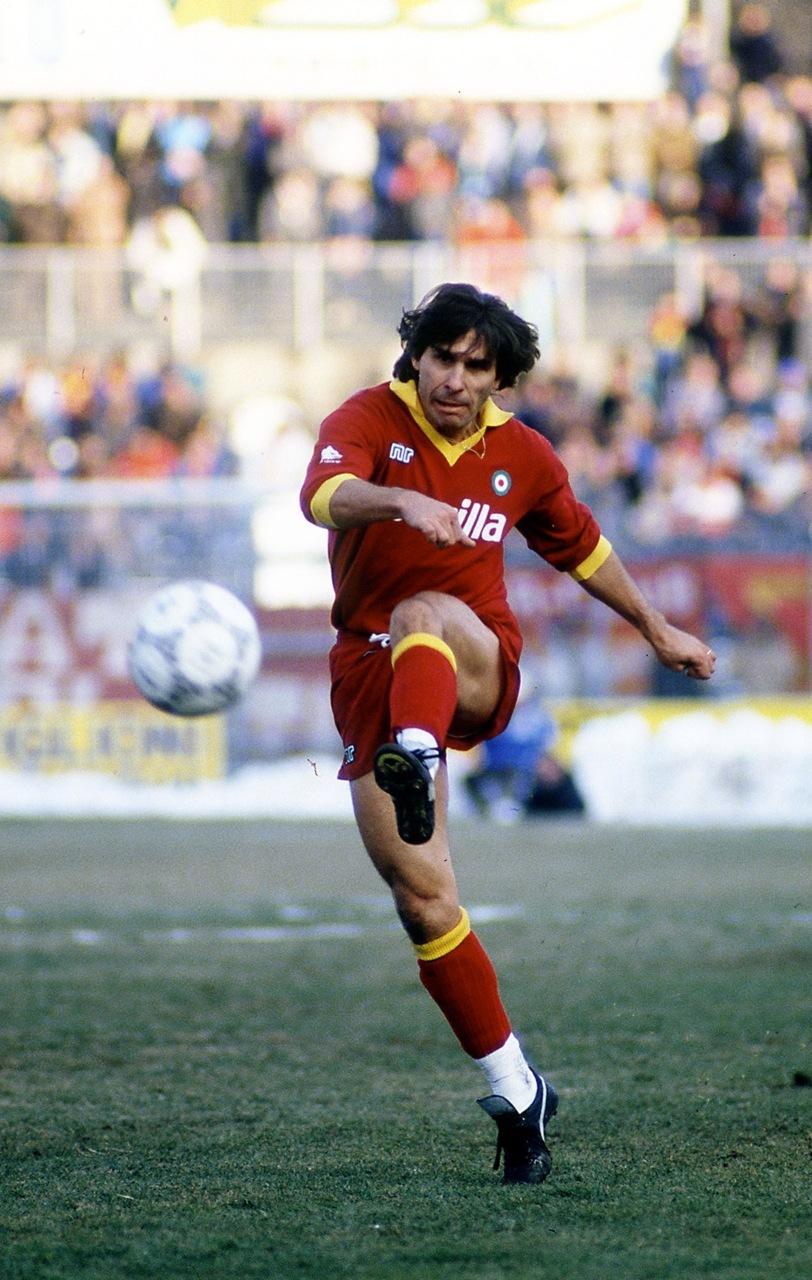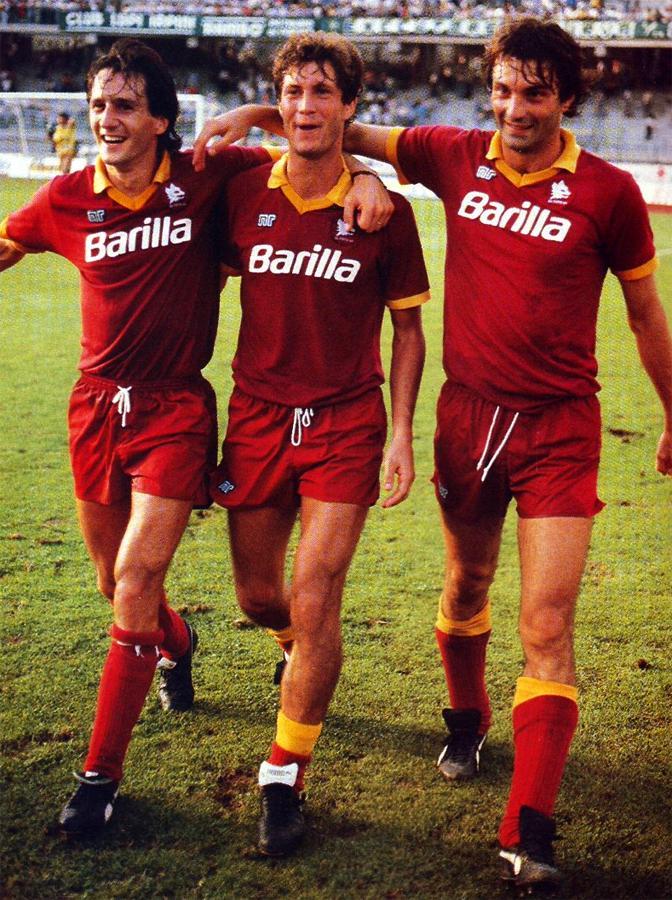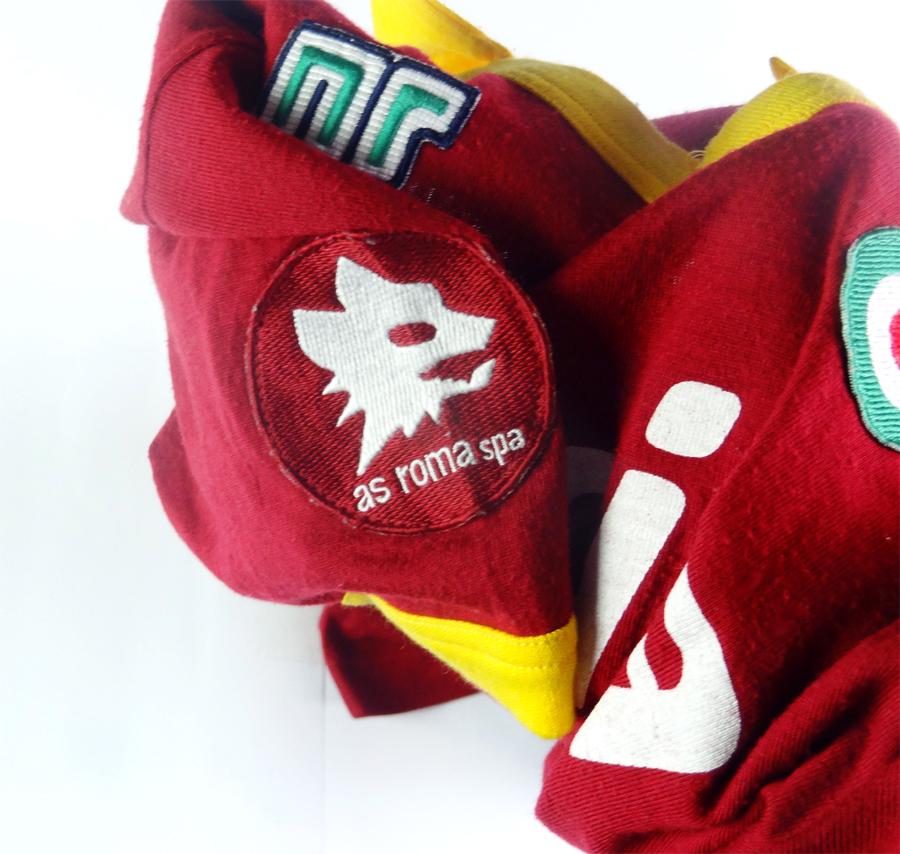Shirt: Roma
Season: 1986-91
Manufacturer: Ennerre
Sponsor: Barilla
Worn by: Bruno Conti, Carlo Ancelotti, Zbigniew Boniek, Gianluca Signorini, Giuseppe Giannini, Aldair, Daniele Massaro, Rudi Völler, Thomas Berthold, Stefano Desideri, Fabrizio Di Mauro.
A.S. Roma’s history may not be as illustrious as those of Juventus, Milan or Inter, but they’ve not done badly. Some statistics: Roma, alongside Juventus, have competed for every Scudetto bar one (only Inter have a better record, having played every season in Serie A since its inception in 1909). They have triumphed thrice and finished as runners up on 14 occasions. Nine Coppa Italia victories have been recorded, second only to Juventus with 13. I Giallorossi – ‘the yellow and reds’ – have also played their fair share of European football, although they failed to win either of the two finals they contested.
All things considered, being a Roma supporter has been worth the bother, and especially so during the 1980s. They kicked off the decade with two consecutive Coppa Italia victories – both won on penalties against the same opposition, Torino. Concurrently, Roma’s league form gradually improved. They ended the season in sixth place in 1979/80, came second in ‘80/81, third in ‘81/82, before finally securing their second ever Serie A title in ‘82/83, wearing gear manufactured by Belgian sportswear company Patrick.
Despite failing to defend their scudetto, Roma made a good go of it in 1983/84: they came second in the league, bagged their fifth Coppa Italia, and were runners up to Liverpool in the 1984 European Cup final (Liverpool decked out in red, A.S. Roma in white). By now Roma’s shirts were supplied by Kappa, an association that would last three years, culminating in yet another Coppa Italia triumph in 1986, beating Sampdoria over two legs. Thereafter, Roma formed an alliance with Ennerre that would run until 1991, whereupon they switched to Adidas.

Bruno Conti sporting Roma’s 1986/87 Ennerre kit.
Mutatis mutandis, the Ennerre kit was neither very different to the Kappa strip that preceded it nor the Adidas version that came after: coloured Tyrian purple, which inclines towards red, with shorts and socks to match. The most significant disparity between the Kappa shirt and the Ennerre iteration was the tone of the trim – orange in the first instance, a golden yellow in the next. The difference between the Ennerre and Adidas shirt was even slighter, the only discernible change being the addition of Adidas’s iconic stripes upon the shoulder. All three shirts even brandished the same sponsor – pasta producer Barilla.
Ennerre hooked up with Roma during what was supposed to be Sven-Göran Eriksson’s third season in charge – 1986/87. The corresponding jersey – more than likely made from Ennerre’s infamous cotton/wool blend ‘lanetta’ – bore the coccarda but failed to inspire anything higher than a seventh place finish in the league and a second-round exit in the Coppa Italia (courtesy of Bologna). Eriksson was shown the door in May, Angelo Sormani took temporary charge before Nils Liedholm – the man who had guided A.S. Roma to their title win in 1983 – re-joined the club, no doubt intent on resurrecting past glories.
Notwithstanding the loss of Carlo Ancelotti to AC Milan – from where Leidholm had just came – Roma looked a decent proposition ahead of the 1987/88 campaign. Club legends Giuseppe Giannini and Bruno Conti were still present and correct, Polish midfielder Zbigniew Boniek had another season left in him, and the new coach was able to lure promising defender Gianluca Signorini from Parma (who would leave after one season for Genoa) and the highly coveted German striker Rudi Völler from Werder Bremen. And so it proved to be. Völler took time to settle but Giannini rose to the occasion scoring 11 times from his position in midfield, helping Roma to secure third place behind Napoli and AC Milan, thus qualifying for the UEFA Cup.

From left: Defensive trio Antonio Tempestilli, Fulvio Collovati and Gianluca Signorini are in good spirits following a 3-2 win at Avellino (September 27, 1987).
1988/89’s campaign failed to meet the expectations the previous one conferred upon it. Roma were knocked out in the third round of the UEFA Cup by East German minnows Dynamo Dresden, only made it as far as the second round of the Coppa Italia, and finished a disappointing seventh in Serie A. Nils Liedholm was sent packing, as were the under-performing Brazilian pairing of Andrade and Renato. On a brighter note, Rudi Völler appeared to be finding his feet, having scored 15 goals in all competitions.
Perhaps conscious that A.S. Roma’s form had begun to stagnate, Ennerre switched the configuration of the club’s crest – the classic ‘wolf’s head’ emblem the club introduced in 1977, and abandoned in 1997 – with their company logo; the badge was transposed to the right, Ennerre’s logo to the left. It seemed to have the desired effect. Roma finished the season in sixth place and made it to the semi-finals of the Coppa Italia, losing narrowly to eventual winners Juventus. The slight improvement in the club’s fortunes may more realistically be attributed to the appointment of Luigi Radice as coach.
At any rate, club president Dino Viola had already decided he wanted Ottavio Bianchi to assume coaching responsibilities, and would have employed him a year earlier if Bianchi’s contract with Napoli had allowed for it. (Radice had not been made aware of this and it left a sour taste in his mouth when it became clear that he’d merely been hired as temporary cover whilst Roma waited for Bianchi to become available.) Ottavio Bianchi, when he finally arrived in the summer of 1990, enlisted the services of his ex-Napoli employee Andrea Carnevale, who was very quickly caught out on a doping violation, along with goalkeeper Angelo Peruzzi, and banned from competing for the next 12 months. Brazilian defender Aldair signed from Benfica, shoring up a defence that already included the German centre-back Thomas Berthold.
Meanwhile, Ennerre had finally decided to ditch the lanetta and embrace polyester. In every other respect the shirt was pretty much the same, save for two strands of yellow piping running diagonally from the neck down to under the arm. Further, as at Napoli, the manufacturer appeared to supply two versions of the same shirt: one in unembellished polyester and the other micro-patterned to create a motif out of Ennerre’s magnificent logo.
Roma’s league form was subsequently erratic and they could only manage ninth place. However, in the UEFA Cup they ran riot and lost only narrowly over a two-legged final to Italian rivals Inter (Rudi Völler was the competition’s leading scorer with 10 goals). Then, less than a month later, Roma sealed an empathetic 4-2 aggregate victory over Serie A winners Sampdoria in the Coppa Italia.
The Curva Sud faithful would have to wait another ten years before their team lifted another trophy – A.S. Roma’s third scudetto – by which time they’d reverted to wearing white shorts and black socks. Actually, Roma’s kit has fared better over the years than many of their rivals’, but there’s something unusually attractive about the all-red, collared iteration they wore throughout the 1980s.
Words by James Evans: @JDEvans75
For vintage and match-worn Roma shirts Click here.


